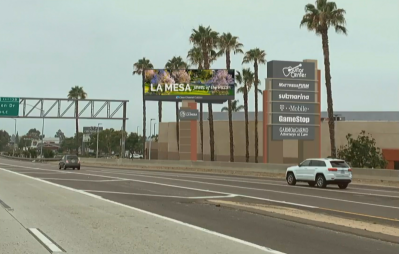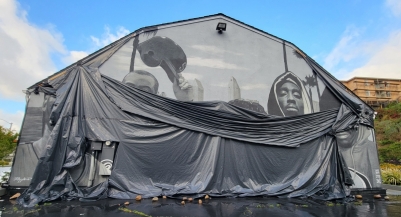 By Jessyka Heredia
By Jessyka Heredia
April 2, 2023 (La Mesa) -- Clear Channel Outdoor Vice President of Public Affairs Layne Lawson gave the La Mesa City Council a presentation on a proposed digital billboard plan during the March 28 Council meeting. The company is proposing that the City enter a development agreement with Clear Channel for two digital billboards that would display advertisements generating an annual development fee payment of $125,000 per new advertising structure for the City, plus a 3% annual increase, starting in the second year.
The two locations that would have digital advertising are at 8805 Murray Drive and 8703 Murray Drive. Both digital signs are visible from Interstate 8 and would have two digital faces.
The 8805 Murray Drive billboard by Guitar Center would be constructed first and would also include replacing the current on-site signs that display the names of the businesses located in that plaza. The plan would be to remove a sign located at 8265 Commercial Street and instead construct the new sign at the 8805 Murray Drive location, to avoid creating excessive billboards in the city. An additional structure at a location to be determined later will be removed at the time the 8703 Murray Drive location is built. In addition, the current City-owned sign at the golf course in MacArthur Park would be removed and replaced with a new digital sign that would not feature commercial ads, but instead feature community and city events.
Layne said Clear Channel Outdoor has preliminary approval from Caltrans, assuming Clear Channel enters an agreement with the City.
Councilmembers Laura Lothian and Patricia Dillard both expressed their appreciation that the digital signs were in “commercial areas and not near homes.” Councilmember Jack Shu had concerns with the electronic billboards being a “traffic hazard” adding, “These signs have been forbidden in many cities, sometimes in cities close to us, because of the traffic hazards.”
Vice Mayor Collin Parent asked if any of the Councilmembers would volunteer to head a subcommittee on the matter for further research and discussion moving forward. Both Shu and Dillard agreed to do that. Dillard explained she “wants to counter Shu” on the matter of traffic safety concerns as her motive on the subcommittee.
 Recently, the City of Lemon Grove entered a similar agreement with OUTFRONT Media for a double-sided digital sign at the Lemon Grove Avenue offramp on the 94 freeway with an annual revenue of $325,000 to the city.
Recently, the City of Lemon Grove entered a similar agreement with OUTFRONT Media for a double-sided digital sign at the Lemon Grove Avenue offramp on the 94 freeway with an annual revenue of $325,000 to the city.
Also on the agenda was consideration of adopting a policy on public art, including possibly imposing fees on new developments to fund public art as well as whether or not to authorize murals on private property.
In the presentation to the Council, Community Services Director Susan Richardson explained that there is no fiscal impact associated with this item, with the exception of an undetermined amount of revenue for future arts projects. Richardson described some of the benefits of public art, such as it “increases the public’s access to the arts, enhances neighborhood identity as well as encourages economic development.”
The Council was asked to consider imposing a public art development impact fee on new developments in order to assist the City in defraying costs associated with public art programs, as well as consider changing Title 15 of the city’s Municipal Code to allow murals on private property.
When it came to the authorization of murals on private property, some of the discussion was centered around the currently covered mural at The Backpack Boys Dispensary on Parkway Drive. The Council heard a public comment from resident Melissa Weiss, who advocated for the mural at the dispensary saying, “city officials have decided to interpret the sign ordinance in a way that bans murals.” She begged the Council to consider a “system that truly encourages and supports the creation of murals.” Weiss asked the Council to “allow the mural of deceased black athletes on the Backpack Boys business to be uncovered. The community has been missing out on a beautiful tribute by a renowned Korean muralist for an entire year.”
All of the Councilmembers spoke about supporting more public art in the city. Parent and Lothian talked of cities that have shown great examples of murals around their cities like Sacramento and Nashville. Lothian also mentioned murals in Ramona and how “they do it with fundraising.”
Councilmember Shu liked the fee component on new development to make sure “artists are paid” and not always asked to perform for free.
Both Vice Mayor Parent and Lothian were not interested in the developer impact fees. Parent said he was all for “creating funding mechanisms for the arts; it can’t be by making housing more expensive. He offered a motion to decline the residential development impact fees and to direct staff “to no longer bring new development impact fees to the city.”
Shu said he would be inclined to oppose that, because developers would not likely feel the impact of such a fee as the art would “increase values and invite people in”.
Council directed staff to approve the motion presented by Parent to reject the developer impact fees by a 3-1 vote, with Shu opposed and the Mayor absent from the meeting. A subcommittee was formed to further discuss the allowance of murals on private property, after Shu raised concerns that the city has several murals around town that are on private property already and some have not been cited.
Vice Mayor Parent and Councilmember Shu brought forward a Council-initiated agenda item asking Council to direct staff to “require new residential developments to decouple parking for new multi-family developments seeking entitlement.”
In Shu’s statements to his Council colleagues, he explained that decoupling is when an apartment is rented separately from the parking spot. “What that allows is renters that do not have a vehicle are not having to pay for a parking space, so it makes the people who have vehicles pay for that parking.” If someone has two vehicles, they may have to pay a bit more, he added. “It helps us reduce our dependence on vehicles” and “reward those who don’t have vehicles “. Shu claimed, “Communities that do this find it works much better, and the renters are happier.”
Parent added, “This would ensure that if someone is renting or purchasing a unit and they don’t have a car and don’t want parking, they aren’t forced to pay the same amount as someone in an adjacent unit who doesn’t have that same amenity.”
Lothian said, “You are trying to discourage parking and cars. Why are we trying to make it miserable to have a car?” She called it “punitive” and added, “Most people can’t function without a car.”
Councilmember Dillard asked, “If you had a complex for rent and you had enough parking spaces for all the units and the management decided to rent them out, is there any limit per unit or could they rent out five?”
Parent replied. “A developer can build as much parking as they want” and said there are no restrictions on how many currently they could rent to a unit. “People who are renting apartments would have to set a price for the apartment and then set a separate price for the parking,” he said.
The motion passed 3-1 with Lothian casting the only no vote, stating, “I don’t know why we are moving in this direction.”














Recent comments